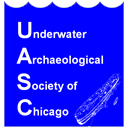Underwater Archaeological Society Of Chicago
Meeting Minutes
August 30, 2017
Treasurer’s Report
John Bell reported the total in the treasury with $800 being spent this dive season.
Adopt A Beach ~ Sep. 16, 2017
Greenwood Beach, Evanston. Dean Nolan reported that this site is where the shipwreck Morley is. There will be food and entertainment.
ICSSD Presidents’ Night Banquet ~ Oct. 21, 2017
Mack’s Golden Pheasant Restaurant, 668 W. North Ave., Elmhurst, IL. Cocktails at 6:00pm, dinner at 7:00pm. Ticket price $35.00pp
Chicago Maritime Museum
Jim Jarecki has received a grant for the collections assessment program. These are the 100 boats in offsite storage. Work at Crowley’s continues.
Newsletter
There will be one newsletter by year’s end.
Our World Underwater ~ Feb. 17-18, 2018
Marriott O’Hare. Dean Nolan briefly discussed the cost effectiveness of having a booth at OWU. Jim Jarecki suggested changing the display on the backdrop.
Mystery Ship
There may be a charter going out Sep. 3rd or 10th . Tony Kiefer gave a brief update on the survey. It included the fact that the wreck had no transom and the main change from the photomosaic made 15 years ago is the presence of zebra mussels. There is no sign of engine mounts or that there was a boiler, but there is evidence that the boat was burned. Chains are near the front of the boat where there would be the 30-foot long bowsprit or mast with a 6-12” diameter.
Future Short Presentations
Sep. 27 - Tony Kiefer
Oct. 25 - Jim Jarecki
Future Feature Speakers
Sep. 27 - Paul Ehorn
Oct. 25 - Dave Truitt & Harvey Moshman, Heroes On Deck
Nov. 29 - Greg Borzo
New Business
Association for Great Lakes Maritime History, Sep. 7-9, Whitefish Point. Also briefly discussed were the pros and cons of having corporate or group memberships to the UASC.
The meeting adjourned after a presentation by the feature speaker, Patrick McBriarty who gave a comprehensive talk about 1812 Chicago including the Ft. Dearborn Massacre.
Synopsis of the presentation: A Scalping, A Murder and A Massacre.
John Kinzie, born in Quebec, was a trader at and became an interpreter for Fort Dearborn. He had been established for decades as being a fair trader with the Indians. Fort Dearborn was the location of his third trading post in the US, but he charged exorbitant prices for enlisted men. He was very tall at 5’10”, played the violin and had a charismatic personality. Unfortunately, he lost his common-law wife and family when her father came and took her back to the east coast. Kinzie later bought an estate from Jean Baptiste Point du Sable, the first resident of Chicagou (original spelling) who was of African descent. He didn’t read or write but had his own accounting system. He owned the first estate in the area and it dated from 1770-1780. The estate consisted of a two-story forty by twenty-foot cabin with two fireplaces, barns and a smokehouse. After a (non-local) Indian attack on Lee farm on April 6, 1812, settlers fled to the fort. Two soldiers who were fishing were scalped and killed. The US Secretary of War gave permission for the fort to be strengthened. There were few soldiers in these outposts with only 50 to 60 stationed at Fort Dearborn. Two rows of tall picket fences now surrounded it and two blockhouses were added. There were two two-floor buildings, officers’ quarters, a store and a powder magazine. Chicago first showed up on Marquette and Joliet’s 1673 map. A 1798 map didn’t even show the Indian villages.
On June 17, 1812, a day before Congress declared war on Britain, Kinzie stabbed the fort interpreter Jean Laline and slit his throat. Although he claimed it was an “inconvenient accident”, he fled. While away, he sat on a pro-British Indian council in Milwaukee since he was thought to be pro-British after the murder. The Indians could sway the war against Britain, but they had guns without ammunition. Because of the tense war situation and the fact that they needed him, Captain Nathan Heald allowed Kinzie back to the fort on July 13th. Kinzie spoke French, English and Indian languages. He wasn’t arrested because he had been appointed officer of the peace in 1806 and obviously, wouldn’t arrest himself.
In 1812, General Hull ordered everyone in Fort Dearborn to retreat to Fort Wayne because the Chicago-area fort was too far away to resupply. Heald was allowed to use extra supplies to bargain with the Indians for safe passage. This was told to the 14 Indian chiefs who went to the fort. On August 4, Indians arrived to receive them and by the 15 th when the settlers left, there were 500 around the fort waiting for the promised supplies. The settlers destroyed the powder and poured alcohol into the Chicago River. There was so much that the river water tasted like grog. When the settlers were about 1 ½ miles away, Tecumseh received word that the British had taken the fort at Mackinaw. Then there was an attack at around 18th street and Prairie, but it’s not certain who fired first. Kinzie and his daughter were escorted away from the battle by a chief and were put in a boat on the Chicago River. Out of the 100 settlers, there were a dozen survivors and a dozen who were taken captive. A surviving soldier was protected by three Indian women and he joined the tribe. Fort Dearborn was rebuilt in 1816 and lasted for forty more years. Kinzie also came back. This can be justified as a battle and not a massacre because treaties had been broken. Also, a reason for the attack could be that the Indians needed the promised supplies, especially the guns and ammunition, in order to survive the winter.
Minutes respectfully submitted by Claire Gadbois and Carol Sommers
